Zeheng Wang
Quantum Machine Learning for Semiconductor Fabrication: Modeling GaN HEMT Contact Process
Sep 17, 2024
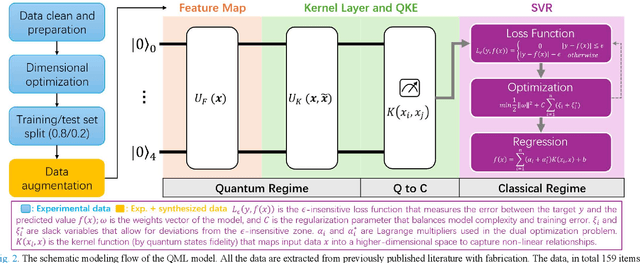
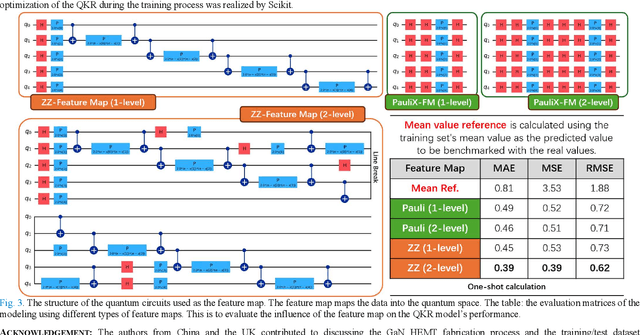
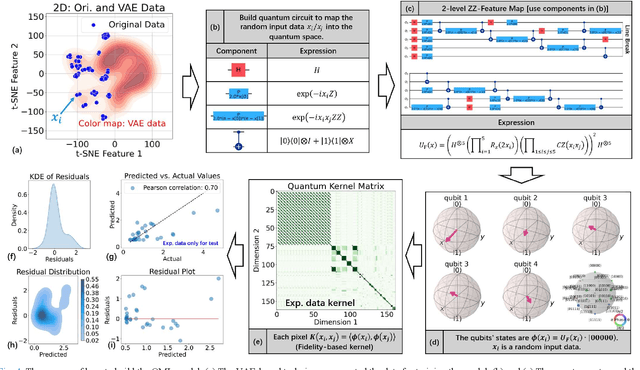
Abstract:This paper pioneers the use of quantum machine learning (QML) for modeling the Ohmic contact process in GaN high-electron-mobility transistors (HEMTs) for the first time. Utilizing data from 159 devices and variational auto-encoder-based augmentation, we developed a quantum kernel-based regressor (QKR) with a 2-level ZZ-feature map. Benchmarking against six classical machine learning (CML) models, our QKR consistently demonstrated the lowest mean absolute error (MAE), mean squared error (MSE), and root mean squared error (RMSE). Repeated statistical analysis confirmed its robustness. Additionally, experiments verified an MAE of 0.314 ohm-mm, underscoring the QKR's superior performance and potential for semiconductor applications, and demonstrating significant advancements over traditional CML methods.
Open-World Test-Time Training: Self-Training with Contrast Learning
Sep 15, 2024Abstract:Traditional test-time training (TTT) methods, while addressing domain shifts, often assume a consistent class set, limiting their applicability in real-world scenarios characterized by infinite variety. Open-World Test-Time Training (OWTTT) addresses the challenge of generalizing deep learning models to unknown target domain distributions, especially in the presence of strong Out-of-Distribution (OOD) data. Existing TTT methods often struggle to maintain performance when confronted with strong OOD data. In OWTTT, the focus has predominantly been on distinguishing between overall strong and weak OOD data. However, during the early stages of TTT, initial feature extraction is hampered by interference from strong OOD and corruptions, resulting in diminished contrast and premature classification of certain classes as strong OOD. To address this, we introduce Open World Dynamic Contrastive Learning (OWDCL), an innovative approach that utilizes contrastive learning to augment positive sample pairs. This strategy not only bolsters contrast in the early stages but also significantly enhances model robustness in subsequent stages. In comparison datasets, our OWDCL model has produced the most advanced performance.
Quantum Kernel Principal Components Analysis for Compact Readout of Chemiresistive Sensor Arrays
Aug 28, 2024



Abstract:The rapid growth of Internet of Things (IoT) devices necessitates efficient data compression techniques to handle the vast amounts of data generated by these devices. In this context, chemiresistive sensor arrays (CSAs), a simple-to-fabricate but crucial component in IoT systems, generate large volumes of data due to their simultaneous multi-sensor operations. Classical principal component analysis (cPCA) methods, a common solution to the data compression challenge, face limitations in preserving critical information during dimensionality reduction. In this study, we present quantum principal component analysis (qPCA) as a superior alternative to enhance information retention. Our findings demonstrate that qPCA outperforms cPCA in various back-end machine-learning modeling tasks, particularly in low-dimensional scenarios when limited Quantum bits (qubits) can be accessed. These results underscore the potential of noisy intermediate-scale quantum (NISQ) computers, despite current qubit limitations, to revolutionize data processing in real-world IoT applications, particularly in enhancing the efficiency and reliability of CSA data compression and readout.
Blue and Green-Mode Energy-Efficient Chemiresistive Sensor Array Realized by Rapid Ensemble Learning
Mar 03, 2024Abstract:The rapid advancement of Internet of Things (IoT) necessitates the development of optimized Chemiresistive Sensor (CRS) arrays that are both energy-efficient and capable. This study introduces a novel optimization strategy that employs a rapid ensemble learning-based model committee approach to achieve these goals. Utilizing machine learning models such as Elastic Net Regression, Random Forests, and XGBoost, among others, the strategy identifies the most impactful sensors in a CRS array for accurate classification: A weighted voting mechanism is introduced to aggregate the models' opinions in sensor selection, thereby setting up wo distinct working modes, termed "Blue" and "Green". The Blue mode operates with all sensors for maximum detection capability, while the Green mode selectively activates only key sensors, significantly reducing energy consumption without compromising detection accuracy. The strategy is validated through theoretical calculations and Monte Carlo simulations, demonstrating its effectiveness and accuracy. The proposed optimization strategy not only elevates the detection capability of CRS arrays but also brings it closer to theoretical limits, promising significant implications for the development of low-cost, easily fabricable next-generation IoT sensor terminals.
Improving Machine Learning-Based Modeling of Semiconductor Devices by Data Self-Augmentation
May 25, 2021



Abstract:In the electronics industry, introducing Machine Learning (ML)-based techniques can enhance Technology Computer-Aided Design (TCAD) methods. However, the performance of ML models is highly dependent on their training datasets. Particularly in the semiconductor industry, given the fact that the fabrication process of semiconductor devices is complicated and expensive, it is of great difficulty to obtain datasets with sufficient size and good quality. In this paper, we propose a strategy for improving ML-based device modeling by data self-augmentation using variational autoencoder-based techniques, where initially only a few experimental data points are required and TCAD tools are not essential. Taking a deep neural network-based prediction task of the Ohmic resistance value in Gallium Nitride devices as an example, we apply our proposed strategy to augment data points and achieve a reduction in the mean absolute error of predicting the experimental results by up to 70%. The proposed method could be easily modified for different tasks, rendering it of high interest to the semiconductor industry in general.
An Ontology-Based Artificial Intelligence Model for Medicine Side-Effect Prediction: Taking Traditional Chinese Medicine as An Example
Sep 12, 2018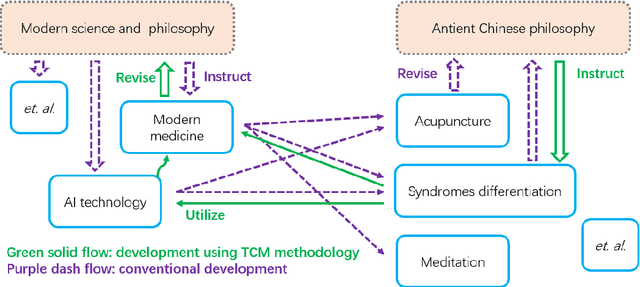
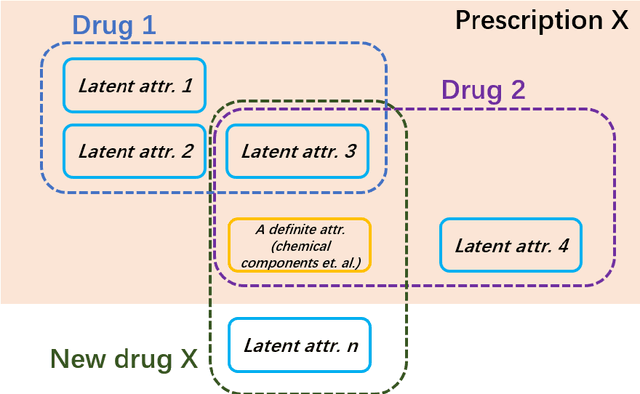
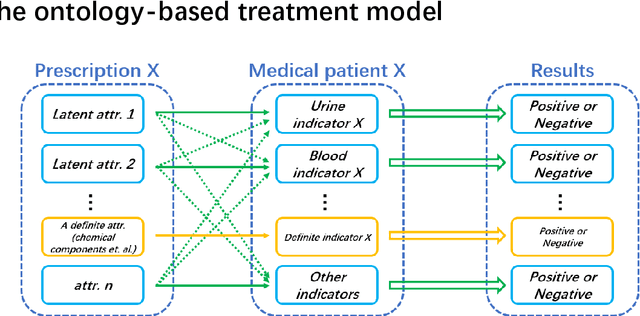
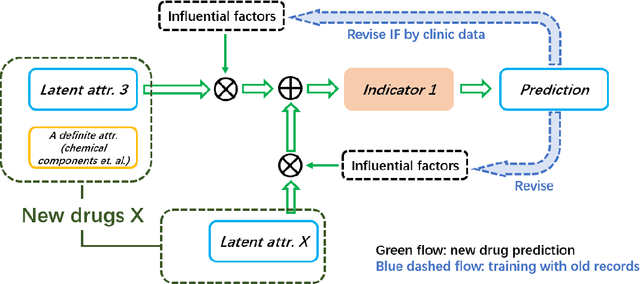
Abstract:In this work, an ontology-based model for AI-assisted medicine side-effect (SE) prediction is developed, where three main components, including the drug model, the treatment model, and the AI-assisted prediction model, of proposed model are presented. To validate the proposed model, an ANN structure is established and trained by two hundred and forty-two TCM prescriptions that are gathered and classified from the most famous ancient TCM book and more than one thousand SE reports, in which two ontology-based attributions, hot and cold, are simply introduced to evaluate whether the prediction will cause a SE or not. The results preliminarily reveal that it is a relationship between the ontology-based attributions and the corresponding indicator that can be learnt by AI for predicting the SE, which suggests the proposed model has a potential in AI-assisted SE prediction. However, it should be noted that, the proposed model highly depends on the sufficient clinic data, and hereby, much deeper exploration is important for enhancing the accuracy of the prediction.
 Add to Chrome
Add to Chrome Add to Firefox
Add to Firefox Add to Edge
Add to Edge